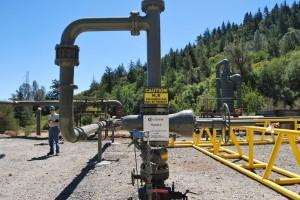 Mount Hood and Crater Lake may be Oregon’s most famous volcanic sites, but a much lesser known companion may soon be joining them. While lacking the towering cone of Hood, Newberry Crater is actually the largest of the Cascade Range volcanoes, covering 1,200 square miles (or about the size of the state of Rhode Island). The U.S. Geological Survey considers Newberry Crater a “high risk” volcano because of its relatively recent history of eruptions and the rapidly growing population of the nearby city of Bend. At the same time, its superheated rocks deep below the surface, along with its proximity to a metropolitan area, make it a potentially ideal source of geothermal energy. New geothermal drilling techniques—including innovative technologies utilizing biodegradable and recyclable materials—could soon be bringing this vision closer to reality.
Mount Hood and Crater Lake may be Oregon’s most famous volcanic sites, but a much lesser known companion may soon be joining them. While lacking the towering cone of Hood, Newberry Crater is actually the largest of the Cascade Range volcanoes, covering 1,200 square miles (or about the size of the state of Rhode Island). The U.S. Geological Survey considers Newberry Crater a “high risk” volcano because of its relatively recent history of eruptions and the rapidly growing population of the nearby city of Bend. At the same time, its superheated rocks deep below the surface, along with its proximity to a metropolitan area, make it a potentially ideal source of geothermal energy. New geothermal drilling techniques—including innovative technologies utilizing biodegradable and recyclable materials—could soon be bringing this vision closer to reality.
On January 12, news media (citing the Associated Press) reported that AltaRock Energy, Inc., one of the developers conducting a pilot project at Newberry Crater, believed that they had successfully created three geothermal reservoirs from a single well where none previously existed. The U.S. Department of Energy, which is funding half of the project cost, has said that if successful this would be the first instance in which multiple reservoirs were created from a single well.
The Newberry Crater project features what is called enhanced geothermal systems, or EGS. The U.S. Department of Energy describes EGS as engineered reservoirs that are created in order to generate energy from geothermal resources that lack water or permeability. To create an EGS, high-pressure cold water is pumped into the rock in a technique known as hydroshearing, which opens existing fissures more widely in order for the water to flow through it. Heated by the rock, the water is brought back to the surface and its heat is converted into electricity, then returned to the ground once after cooling to start the cycle anew. (AltaRock Energy has developed an informative poster of how the EGS at Newberry works.)
Earlier projects at Newberry Crater were stymied because the deep rocks there lacked the cracks and fissures needed in order to create a steam reservoir to generate power. To create the steam reservoirs following hydroshearing, project engineers added a diverter material made up of biodegradable, non-toxic synthetic materials to the water injected into the rock (the AP reported that ground-up recycled plastic bottles were injected). This material plugged up the cracks in one reservoir as cold water was injected into another, and then diffused to create three separate reservoirs. AltaRock Energy said that further testing is needed to confirm whether the reservoirs would be suitable for use for future commercial power production.
If successful, however, this project and the EGS technologies utilized have potentially far-reaching implications for future geothermal energy projects. EGS could be used to generate geothermal power in other locations where water resources are scarce. Moreover, improvements of these technologies could reduce costs and make geothermal a more cost-effective energy resource. AltaRock Energy President and CEO Susan Petty, in an interview with Sustainable Business Oregon last year, said that “If we could double the production of the well we could cut the cost of production from 30 percent to 35 percent. If we are really successful, we could cut it by 40 percent to 45 percent.” Not to be overlooked, though, is the important role of recyclable materials in helping enable this groundbreaking approach and offering environmental solutions.
Image Source: KQED QUEST - Some rights reserved

